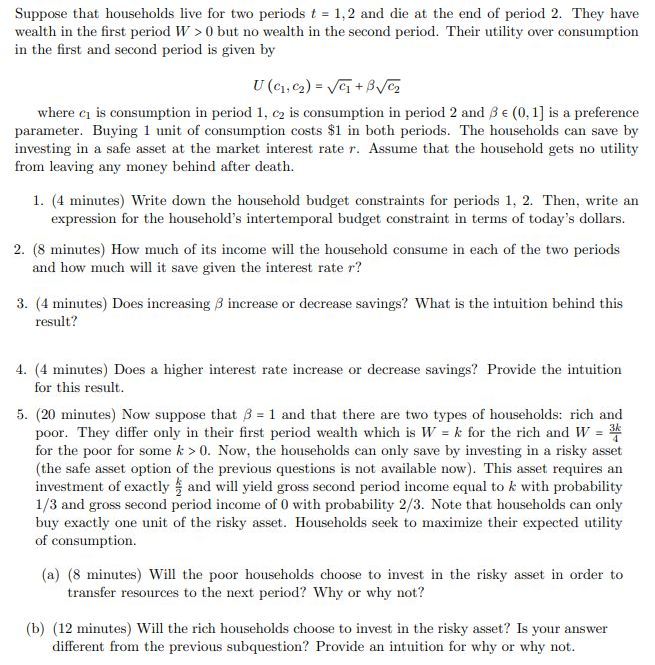Provide solutions to these business questions
Suppose that households live for two periods t = 1,2 and die at the end of period 2. They have wealth in the rst period W 2- [l but no wealth in the second period. Their utility over consumption in the first and semnd period is given by Ui1521= EE'I-v where c1 is consumption in period 1, cg is consumption in period 2 and 13 E [i]. l] is a preference parameter. Buying 1 unit of consumption costs $1 in both periods. The households can save by investing in a safe asset at the market interest rate 1*. Assume that the household gets no utility from leaving any money behind after death. 1. {4 minutes) Write down the household budget constraints for periods 1. 2. Then, write an expression for the household's intertemporal budget constraint in terms of today's dollars. 2. {3 minutm} How much of its immme will the household consume in each of the two periods and how much will it save given the interest rate r? 3. (4 rninutm} Does increasing ,5 increase or decrease savings? What is the intuition behind this result? cl. {4 minutes} Does a higher interest rate increase or decrease savings? Provide the intuition for this result. 5. {20 minutes} Now suppose that 13 = 1 and that there are two types of households: rich and poor. They differ only in their rst period wealth which is W = Jr for the rich and W = for the poor for some It 2: [1. Now. the households can only save by investing in a risky asset {the safe asset option of the previous questions is not available now]. This asset requires an investment of exactly '3' and will yield gross second period income equal to l: with probability US and gross second period income oil] with probability 2H. Note that households can only buy exactly one unit of the risky asset. Households seek to maximise their expected utility of consumption. {a} {3 minutes] Will the poor households choose to invest in the risky asset in order to transfer resources to the next period? Why or why not? (b) {12 minutes] 1Will the rich households choose to invat in the risky asset? Is your answer different from the previous subqution? Provide an intuition for why or why not. (b) (4 minutes) Calculate consumer and producer surplus under trade. (5) (15 minutes) The US government is unhappy with steel imports and decides to impose a 200 percent tariff on imported steel so that the price of imported steel is now 3 when importing from abroad. (Continue to assume that the US domestic steel market operates in perfect competition with production function S(L) = =L) (a) (2 minutes) What is the price of domestic steel? Will car manufacturers choose to use domestic or foreign steel? (b) (5 minutes) Calculate the new equilibrium in the US market for cars, continuing to assume that cars are traded freely at a world price of 100. Does the US still export cars? 4. Beatrice has initial wealth of wo and suffers from quasi-hyperbolic discounting. At any date s, her utility from a consumption stream z = (To, 21, . ..) is U (r s) = In(2.) +8 ) 8 In(x.+2). k=1 where 8, 6 6 (0, 1). She gets return of r > 1 from her savings so that her wealth at t + 1 is ut+1 = " (1 - 2) if her wealth at t is a and she consumes r, at t. (b) Find a sophisticated-optimal consumption strategy for her in which the self at any given date s consumes yu's. Compute the constant y and briefly verify that this is indeed a subgame-perfect equilibrium of the multi-agent game. (c) For 8 " (E) > 0 > > > u (D). Find the condition under which she takes the test








